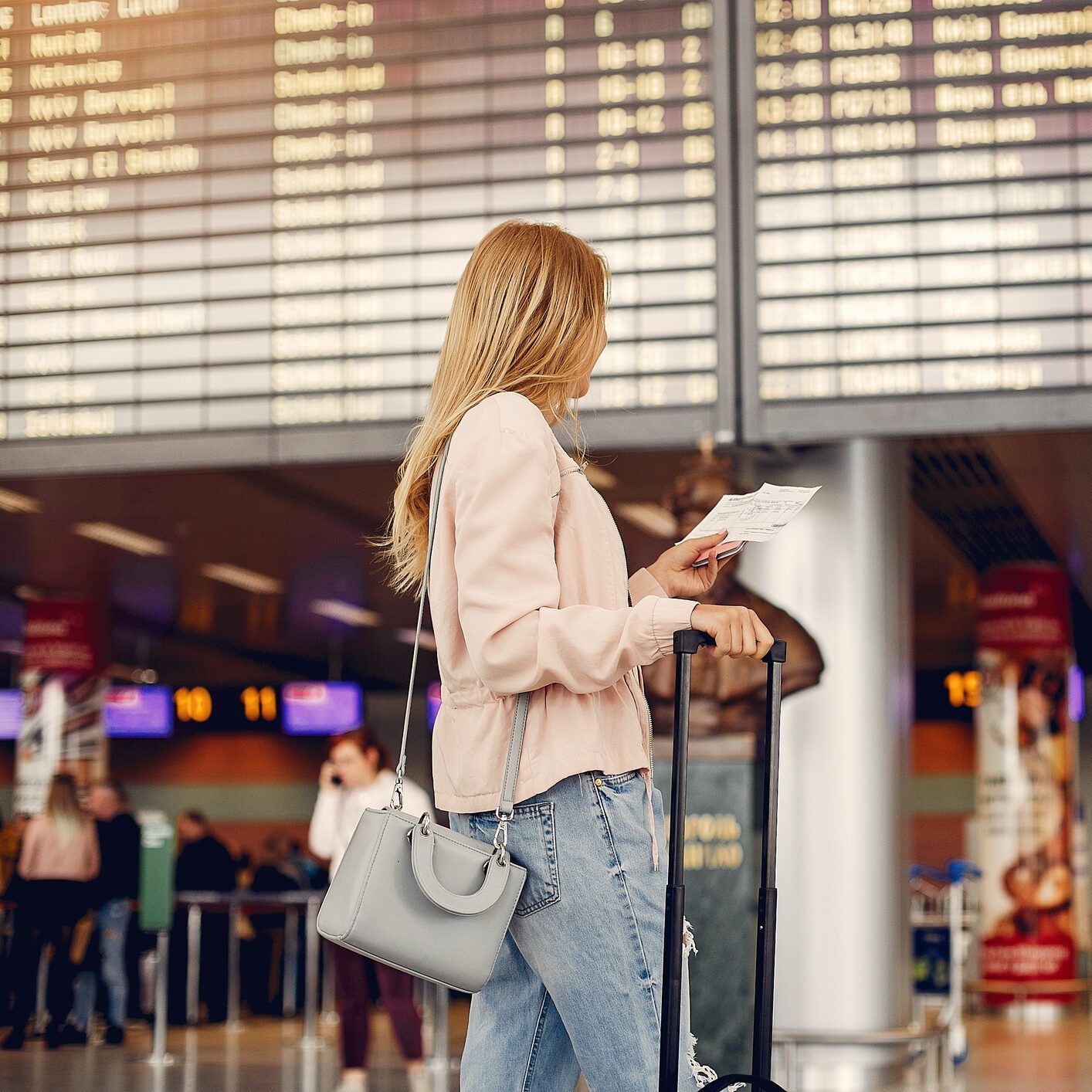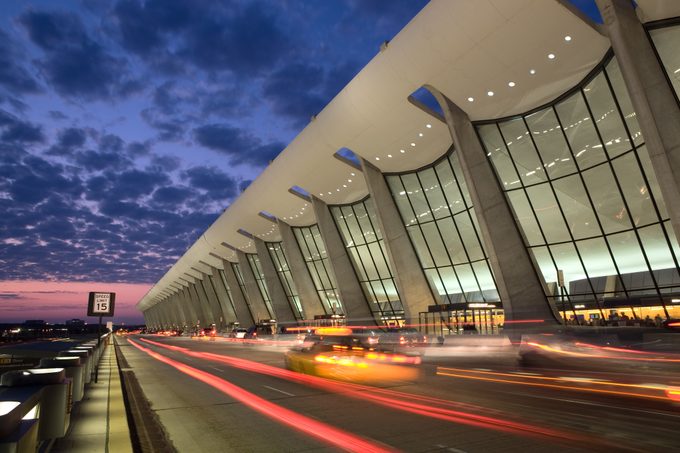Traveling on a budget? Save money by skipping these expensive airports and planning your trip around cheaper alternatives.

If You Fly Out of This Airport, You’ll Pay $100 More Than Average for a Ticket

There’s nothing more exciting than exploring a new vacation destination, but airfare that costs more than the rest of your trip combined can dampen your enthusiasm. Using travel hacks like the “Cheapest” feature from Google Flights can help you save money on airline tickets, but these strategies can only go so far. The fact is, airline prices are rising, and that’s likely to continue throughout 2025.
But there’s still one creative way to save money on flights: Consider the airport you fly from. In a recent report on the average cost of domestic airfare, the Bureau of Transportation Statistics ranked hundreds of U.S. airports, highlighting the most (and least) expensive in the country. So before you book your next plane ticket, read on to learn which U.S. airports will cost you the most money—and which will help you save your cash for your vacation.
Get Reader’s Digest’s Read Up newsletter for more travel, tech, humor, cleaning and fun facts all week long.
How was the most expensive airport determined?
Narrowing down a list of airports to the most expensive in the nation is a big job, but somebody’s got to do it! The Bureau of Transportation Statistics’s Airline Origin and Destination survey collected data about the cost of domestic itinerary fares from all of the airports in the country in the third quarter of 2023. Those fares are based on the value of each ticket, including the price charged by the airline and any additional taxes and fees, excluding baggage fees. The Bureau of Transportation Statistics used the average of those fares to determine where each airport ranks, from most to least expensive.
From there, the agency’s data crunchers ranked the airports based on the number of domestic passengers flying out of them in 2023. Of the 434 airports on the list, those with a highest passenger rank were in major metropolitan areas.
What is the most expensive airport to fly out of in the U.S.?

First, let’s look at the major U.S. airports. When Reader’s Digest whittled down the list to the 50 highest-traffic airports, Washington Dulles International Airport in Washington, D.C., earned the title of most expensive. The average price per domestic ticket there was $473, more than $100 higher than the national average.
If you think that’s bad, you should see the ticket prices at Antonio B. Won Pat International Airport in Guam. On the full Bureau of Transportation Statistics list—which includes airports of all sizes in every U.S. state and territory—it came in as the most expensive. Travelers who fly out of there spend an average of $1,658.81 per ticket. Yikes! That’s more than $1,292 higher than the national average of $366. Four other airports have average ticket prices over $1,000, and all are smaller locations in far-flung regions—think Alaska and American Samoa.
On the plus side, most travelers won’t encounter these steep prices unless they’re purposefully traveling to these distant destinations. Guam, for instance, is a U.S. territory in the western Pacific—not somewhere you’re bound to have a layover on your way to a U.S. hot spot.
What other airports are expensive?
Like Guam, other off-the-beaten path locations tend to have the most expensive airports. Tom Madsen Airport (DUT) in Unalaska, Alaska, has average fares of $1,304.81, while Pago Pago International Airport in American Samoa has fares of $1,237.73 on average.
But let’s look at ticket prices among the 50 busiest airports in America. Here are the most expensive major airports, as well as their average airfares:
- Washington, D.C. (IAD): $473
- Santa Ana, California (SNA): $428
- San Francisco, California (SFO): $425
- Salt Lake City, Utah (SLC): $411
- Detroit, Michigan (DTW): $404
- Newark, New Jersey (EWR): $403
What are the cheapest airports to fly out of in the U.S.?
Some of the cheapest airports in the country are in smaller cities: At Branson Airport in Branson, Missouri, the average plane ticket is just $90.76. And at Hagerstown Regional Airport in Hagerstown, Maryland, tickets are only $94.57 on average.
Narrowing down the list to the top 50 busiest airports does raise fares a bit, but you can still get some great airfare deals. Among those busy airports, these are the cheapest, along with the average airfare:
- Fort Lauderdale, Florida (FLL): $252
- San Juan, Puerto Rico (SJU): $266
- Orlando, Florida (MCO): $270
- Las Vegas, Nevada (LAS): $275
- Chicago, Illinois (MDW): $292
- New York, New York (LGA): $303
What could you save by flying out of a nearby airport?
Sometimes, your travel plans limit your airport options. But if you’re able to fly out of a nearby airport, you might get a better deal. For example, the least-expensive round-trip flight departing from Washington Dulles International Airport for Salt Lake City International Airport on March 15, 2025, will cost you $358. You’ll pay only $292 if you fly out of Ronald Reagan National Airport in Washington, D.C., instead. That single small change could save you $66.
Similarly, a flight from Newark Liberty International Airport in New Jersey to Detroit Metro Airport is $238, while flying out of LaGuardia Airport in New York City brings the price down to just $140. That’s a difference of almost $100!
The lesson in all of this is that doing your research with a flight price tracker and being flexible enough to fly out of a nearby airport on either end of your journey can save you quite a bit of cash.
Why trust us
Reader’s Digest has published hundreds of travel stories that help readers explore the world safely, easily and affordably. We regularly cover topics such as the best places to visit (and the best times to visit them), tips and tricks to zoom through airport security, flight-attendant secrets, hotel-room hacks and more. We’re committed to producing high-quality content by writers with expertise and experience in their field in consultation with relevant, qualified experts. We rely on reputable primary sources, including government and professional organizations and academic institutions as well as our writers’ personal experiences where appropriate. We verify all facts and data, back them with credible sourcing and revisit them over time to ensure they remain accurate and up to date. Read more about our team, our contributors and our editorial policies.
Sources:
- Bureau of Transportation Statistics: “Average Domestic Airline Itinerary Fares by Origin City for Q3 2024”
- CNBC: “Airlines flex pricing power, signaling higher fares in 2025”























